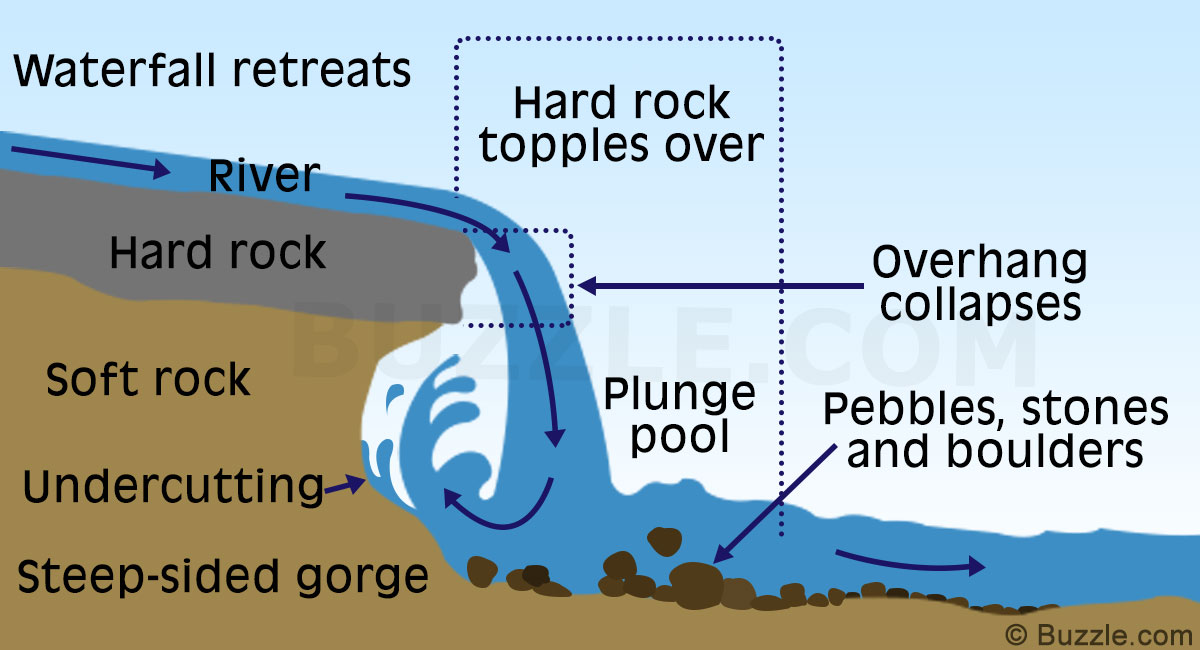River Landscapes
- Created by: megan_d2002
- Created on: 15-10-18 17:33
Drainage basin
Cross Profiles
Upper course-
- source, steep gradient
- valley- steep sided, V shaped
- river- narrow, shallow turbulent
Middle course-
- gentle gradient
- valley- wider, flat floor
- river- wider and deeper
Lower course-
- very gentle gradient, mouth
- valley- very wide and flat
- river- wide, deep, with large sediment load
DB Key Words
Drainage basin- the area of land drained by a river and its tributaries
Source- the start of the river
Tributary- a small stream that joins a larger river
Mouth- the end of a river, usually where it joins the sea
Watershed- the edge of a river basin
Long profile- the gradient of the river, from its source to its mouth
Cross profile- the side-by-side cross section of a river channel and/or valley (downstream)
How does the cross profile change?
Changes are due to the amount of water flowing in the river
As tributaries add more water (and energy) to the river, it erodes its channel, making it wider and deeper
Changes are mainly due to channel erosion, broadening and flattening the base of the valley
Together with weathering and mass movement, these processes mske the sides of the valley less steep
Types of Erosion
Vertical- downwards
Lateral- sideways
Hydraulic action: the force of the water hitting the river bed and banks. Most effective when water is moving fast and at a high volume
Abrasion: the load carried by the river hits the bed or banks, dislodging particles
Attrition: stones carried by the river knock against each other, becoming smaller/ more rounded
Solution: alkaline rocks e.g. limestone, are dissolved by slightly acidic river water
Deposition
When a river's velocity DECREASES, and it no longer has the energy to transport its load, it DEPOSITS it
- Larger rocks: transported mainly by TRACTION are only carried SHORT distances during periods of HIGH FLOW, deposited in UPPER COURSE
- Smaller sediment: carried further DOWNSTREAM mostly in SUSEPNSION, deposited on a river's BED and BANKS where velocity SLOWS due to friction
Lots of depostion occurs at MOUTH where velocity REDUCES because of GENTLE GRADIENT and INTERACTION with tides
Transportation
Load- material transported by the river
The size and the amount of load carried depends on a river's speed or velocity
e.g. after heavy rain, the river looks muddy and carries lots of sediment quickly
Solution- dissolved load
Suspension- small sediment held in the river
Traction- large particles rolled on the river bed
Saltation- 'bouncing' of particles too heavy to be suspended
Course deposition
Upper: erosion landforms e.g. waterfalls
Middle: mostly erosion and deposition ladnforms e.g. meanders and transportation
Lower: mostly deposition landforms e.g. levee
River Landforms- Waterfalls
Waterfalls- as a river flows downstream, it crosses different rock types. More resistant rocks are less easily eroded than less resistant rocks, froming steps in the river'a long profile, which form waterfalls.
Also form when:
- sea levels drop causing river to cut down into its bed creating a step (called a knick point)
- in glacial hanging valleys- a tributary glacial trough on the side of a main valley often with a waterfall)
Gorges Diagram
Waterfall Diagram

River Landforms- Gorges
Gorge- a narrow, steep-sided valley found downstream of a retreating waterfall.
They can form in other ways:
- at the end of the last glacial period, masses of water from melting glaciers poured off upland areas forming gorges (e.g. Cheddar Gorge, Somerset)
- on limestone, when large underground caverns can accomodate an entire river
Meanders Diagram
River Landforms- Interlocking spurs
Interlocking spurs- mountain stream erodes vertically creating a V-shaped valley. It winds around areas of resistant rock to create them
River Landforms- Meanders
Meanders- bends in a river found mainly in lowland areas. They constantly change shape and position.
The thawleg is the line of the fastest current- it swings from side to side causing erosion on the outside bend, and deposition on the inside bend. These processes cause meanders to migrate across the valley floor.
River Landforms- Ox-bow Lakes
Ox-bow lakes- As meanders migrate across the valley floor they erode towards eachother
River Landforms- Floodplains
Floodplains- wide, flat areas on either side of a river in its middle and lower courses. They are created by migrating meanders and floods depositing layers of silt to form alluvium.
River Landscapes- Levees
Levees- when, in low flow, deposition raises the river bed so the channel can't carry as much water. During flooding, water flows over the sides of the channel. As velocity decreases, coarser sediment is deposited first on the banks- then finer sand and mud, raising the height of the levees.
River Landforms- Estuaries
Estuary- where the river meets the sea. They are affected by tides, wave action and river processes. As the tide rises, rivers can't flow into the sea, so velocity falls and sediment is deposited forming mudflats, which develop into salt marshes.


Comments
No comments have yet been made